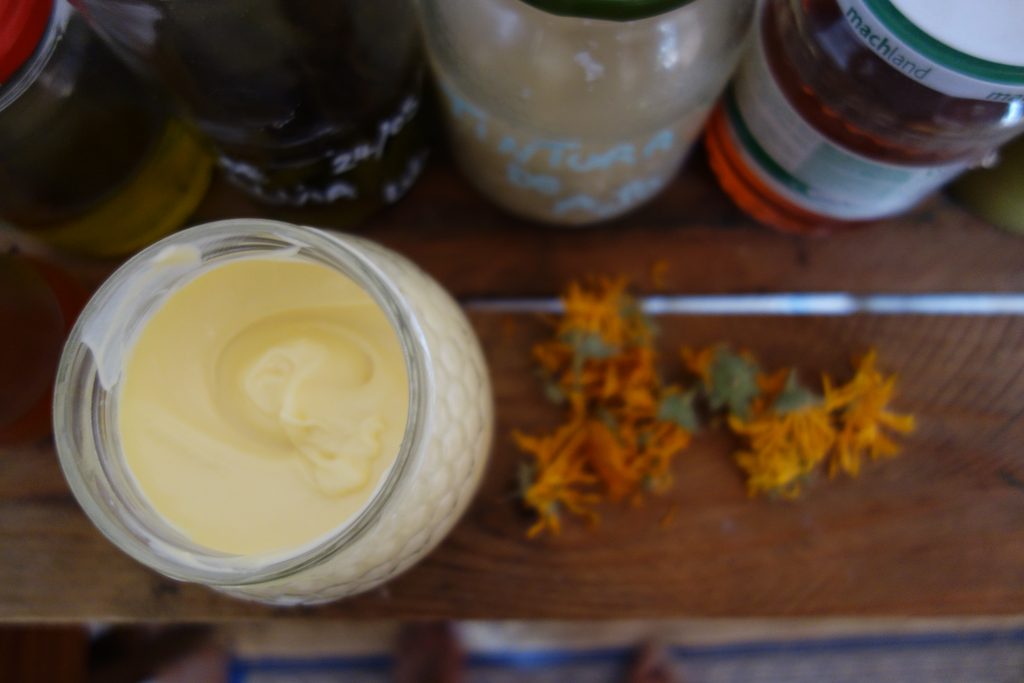Sustainable Living, Tutorial
Part of our mission to live sustainably involves working with the natural abundance that’s at our fingertips to create products that are better for us and our environment. Our Sustainable Living department has been using the beautiful calendula in the Sunseed gardens to make a soothing and hydrating natural moisturiser – and you can make your own with just a few products following the steps below.

Natural Cosmetics – Hydrating Cream (Calendula Base)
To make a cream, you need three main constituents, Oil, Water and an Emulsifier. Once you combine these three in the right quantities and conditions, they form a soft, velvety and hydrating cream.
You can change the thickness and moisture levels of the cream by altering the ratio of oil to water (thicker creams, like a balm, will have much higher emulsifier levels, especially if using beeswax.)
So prepare your ingredients for 100g of cream:
Oil Part (24g in total)
(12g) Almond Oil infused* (see below) with Calendula
(8g) Olive Oil (mild quality, not too strong)
(4g) Emulsifier (i.e Local beeswax or any store bought veg protein, i.e Lanette or Emulsifan)
Water Part (76g in total)
Distilled (or non-chlorinated) water. You can make this a herbal infusion to strengthen the cream, for example with a handful of rose petals, calendula, chamomile, rosemary etc. Be wary that if you add plants to the water part, it will not preserve anywhere near as long.
Preservative Part = Vitamin E (in oil form) or Vitamin C (dehydrated powdered form). If using Beeswax, this acts as a preservative, as it is a natural anti-fungicide.
Essential Oils: (5-10 drops) Any that you feel suit your cream, medicinal purpose, or personal taste. I often use Lavender, given its clean, fresh aroma and anti-bacterial properties.

Method:
- Make an infusion for the water part, leave for 4-12 hours to combine. Preferably water is around 60C-80C, not boiling.
- Mix together all the ingredients for the oil part in a non-metallic bowl (almond, olive oil and emulsifier).
- In separate pans, heat both the oil and water parts to 60C-65C, once they reach this temperature immediately remove from the heat. (NOTE: I often find using a water-bath technique to slowly heat the mixtures a safer approach).
- Now they have been removed from the heat, use a blender to whisk the water part. While its whisking, slowly add the heated oil mixture into the water mix.
- Once evenly mixed, it will form a runny creamy consistency – allow it cool slightly, and then add in your essential oils and Vitamin E/C.
- While still hot, pour the mixture into your cleaned/sterilised jars (when warm is it much easier to pour).
- The cream is ready to use once cool and set, which means it will have thickened.

*Personally, I like to infuse the oils I use with a particular plant, so in this case I chose Calendula for its emollient (skin softening) properties and that it helps sooth burns and mild abrasions/cuts.
*To infuse the oil with a plant, put a handful of the dried herb into a glass jar, fill to the rim with oil and leave for 30-40 days in the sun, turning/softly shake each day. Or for a quicker, but less effective approach, heat the plant (dried or fresh, just use double the amount if fresh) in a saucepan with the chosen oil, bringing it to around 60-65C. Once reached, take of the stove and leave the saucepan covered overnight to infuse. The oil is ready to use the next day (once you’ve filtered the piece of plant out).
Enjoy!
Feel free to get in touch for more information or clarification. To buy the more technical ingredients i.e Lanette, Vitamin E or C and Essential Oils; I use this website: http://www.cremas-caseras.es/ as we are based in Spain; however there are a number of ecological organisations around to source this from over Europe.
Luke – sustainable.living@sunseed.org.uk
Want to learn more about how to create natural cosmetics? Join us as a volunteer in the Sustainable Living department!
